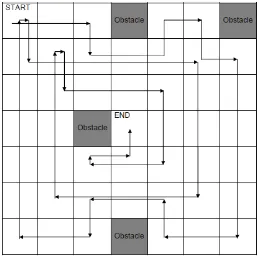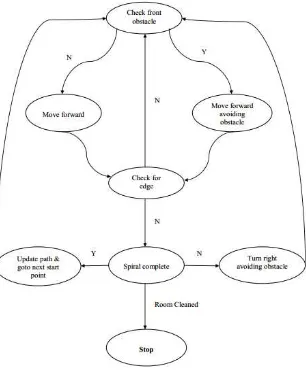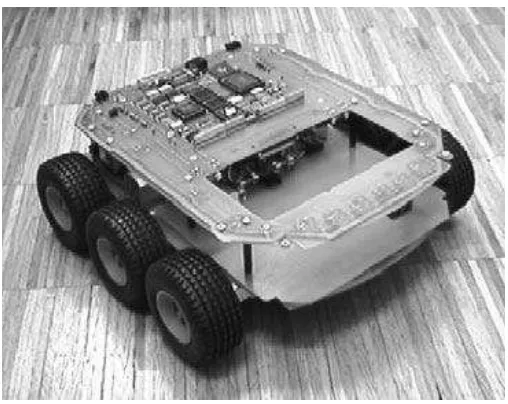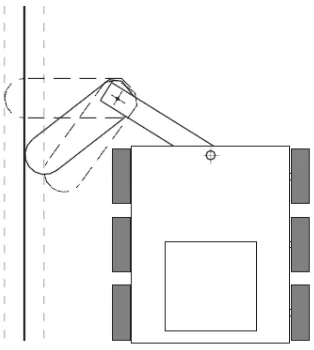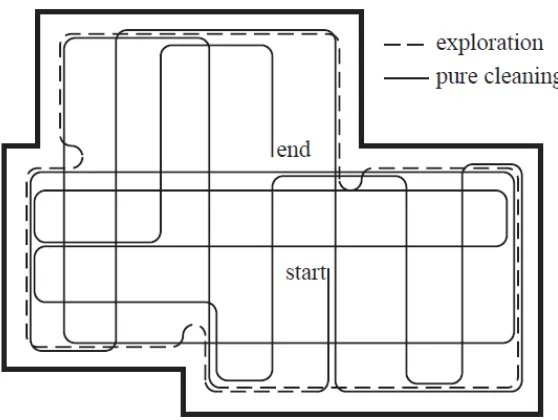MOBILE VACUUM CLEANER ROBOT (MVCR)
MUHAMMAD ZAKI BIN MUSTAPA
This Report Is Submitted In Partial FulfillmentOf Requirements For The Bachelor of Electronic Engineering (Industrial Electronic) with Honors.
Faculty of Electronic Engineering and Computer Engineering UniversitiTeknikal Malaysia Melaka
ii
UNIVERSTI TEKNIKAL MALAYSIA MELAKA
FAKULTI KEJURUTERAAN ELEKTRONIK DAN KEJURUTERAAN KOMPUTER
BORANG PENGESAHAN STATUS LAPORAN
PROJEK SARJANA MUDA II
TajukProjek : Mobile Vacuum Cleaner Robot (MVCR)
SesiPengajian : 1 2 / 1 3
SayaMUHAMMAD ZAKI BIN MUSTAPA mengaku membenarkan Laporan Projek Sarjana Muda ini disimpan di Perpustakaan dengan syarat-syarat kegunaan seperti berikut:
1. Laporan adalah hak milik Universiti Teknikal Malaysia Melaka.
2. Perpustakaan di benarkan membuat salinan untuk tujuan pengajian sahaja.
3. Perpustakaan dibenarkan membuat salinan laporan ini sebagai bahan pertukaran antara institusi
pengajian tinggi.
4. Sila tandakan ( √ ) :
SULIT*
*(Mengandungi maklumat yang berdarjah keselamatan atau kepentingan Malaysia seperti yang termaktubdi dalam AKTA RAHSIA RASMI 1972)
TERHAD** **(Mengandungi maklumat terhad yang telah ditentukan oleh
organisasi/badan di mana penyelidikan dijalankan)
TIDAK TERHAD
Disahkan oleh:
_____________________________________ ___________________________________
(TANDATANGAN PENULIS) (COP DAN TANDATANGAN PENYELIA)
Tarikh: 14 JUNE 2013 Tarikh: 14 JUNE 2013
…………
iii
"I admit that this report is my own work except summary and excerpt of each I have already explained the only source. "
Signature : ...
Author name : MUHAMMAD ZAKI BIN MUSTAPA
iv
"I acknowledge that I have read this work in my work is sufficient in scope and quality for the award of a Bachelor of Electronic Engineering (Industrial Electronics)
with Honors."
Signature : ...
Name of Supervisor : AHMAD NIZAM BIN MOHD JAHARI@MOHD JOHARI
v
DEDICATION
vi
ACKNOWLEDGEMENT
In the name of Allah, the Most Gracious and the Most Merciful, the utmost thanks to Allah with His Greatest power, I have successfully completed this PSM report Alhamdulillah. A special acknowledgement and appreciation goes to my supervisor, Mr. Ahmad Nizam Bin Mohd Jahari for his supervision, commitment, professionalism, advice and guidance in assuring my project succeed. Secondly, I would like to express warm gratitude to the Faculty of Electronic and Computer Engineering Staffs for full co-operation and commitment given to assist me a lot while performing this project
I also want wish the most gratitude to mom, father and family in helps me financially, advice, guidance and in spirit so that I successfully completed this final year project. Without support and inducement from them, I do not can finish my final year project successfully. Thank you I say also to my friends that also directly involved or indirect in giving advice, inducement and skills that they shared with me.
vii
ABSTRACT
viii
ABSTRAK
ix
TABLE OF CONTENTS
CHAPTER 1 2 CONTENT PROJECT TITILE AUTHORIZATION FORM DECLARATION DEDICATION ACKNOWLEDGEMENT ABSTRACT ABSTRAK
TABLE OF CONTENT LIST OF TABLES LIST OF FIGURES
INTRODUCTION
1.1 Project Overview 1.2 Project Objective 1.3 Problem Statement 1.4 Scope Of Project 1.5 Thesis Outline
LITERATURE REVIEW
2.1 1ST review from internet: Cleaning Robot 2.2 2NDreview : Autonomous Vacuum Robot
2.3 3RDreview : review of selection part and component 2.3.1 Sensor
2.3.2 Basic Body 2.3.3 Controller device 2.3.4 Power Supply 2.3.5 Motor
2.4 Literature Review Conclusion
x
3
4
5
METHODOLOGY
3.1 Flow Chart
3.1.1 Collect the Information
3.1.2 Study and design basic structure 3.1.3 Construct basic body with specification 3.1.4 Construct the PIC controller circuit 3.1.5 Construct the movement coding 3.1.6 Apply sonar sensor to PIC and test
3.1.7 Test movement 3.1.8 Finalize the work 3.2 Project Implementation
3.2.1 Mobile Robot Algorithm Design 3.3 Controller
3.3.1 Advantages PIC Microcontroller 3.3.2 Comparison Key Feature of PIC 3.4 PIC Programming Fundamental
3.4.1 Advantage of C language 3.4.2 Basic C Structure for PIC 3.4.3 Pre-processor Directive 3.4.4 Main Program
3.4.5 Functions 3.5 Ultrasonic Sensor
3.5.1 The MaxSonar High Performance Sonar 3.5.2 MaxSonar-EZ1 Feature
3.5.3 MaxSonar-EZ1 Benefits
ANALYSIS AND RESULT
4.1 Chassis development
4.1.1 Raw Material of Mechanical. 4.2 Circuit development
4.2.1 List of electronic component and device 4.3 Product Overview
4.4 Programming development 4.4.1 Programming code 4.5 Ultrasonic and PIC analysis
CONCLUSION AND RECOMENDATION
5.1 Conclusion
5.2 Future Work and Recommendation
xi
REFERENCES
APPENDIX
i. Appendix A ii. Appendix B iii. Appendix C
53
xii
LIST OF TABLES
NO. TABLE TITLE PAGE
2.1 Comparison of sensor 12
2.2 Comparison of material basic body 13
2.3 Comparison of microcontroller 14
2.4 Comparison of batteries 15
2.5 Comparison of motor 16
2.6 Summary 17
3.1 PIC Device Feature 26
3.2 Basic C programming 29
4.1 Raw material for mechanical part 35
4.2 List of electronic and electric part. 40
xiii
LIST OF FIGURES
NO TITLE PAGE
2.1 Rectangular algorithm 7
2.2 State chart of the project design 8
2.3 The koala robot in its commercial version 9
2.4 Mobile robot shape 10
2.5 Wall following 10
2.6 Koala robot modified and equiped with 2DOF arm 10
2.7 Autonomous vacuum cleaner algorithm 11
2.8 Infrared sensor 12
2.9 Ultrasounic sensor 12
2.10 Acrylic plate 13
2.11 Aluminium 13
2.12 68HC11 14
2.13 PIC 16F877 14
2.14 12v lead acid 15
2.15 LiPo 11.1V 15
2.16 Servo motor 16
2.17 Small DC 16
3.1 Flow chart of the methodology 19
3.2 Main window to design the program code 22
3.3 Zigzag algorithm 24
3.4 PIC16F877A Circuit Board 25
3.5 Pin diagram PIC 25
3.6 Block Diagram of MaxSonar-EZ1 30
xiv
4.2 Servo motor bracket 33
4.3 Top view of basic frame 34
4.4 Bottom view of basic frame 34
4.5 Microcontroller circuit 36
4.6 Microcontroller circuit layout 37
4.7 Motor and vacuum driver circuit 38
4.8 Motor and vacuum driver circuit layout 39
4.9 Sonar base plate 39
4.10 Mobile Vacuum Cleaner Robot overview 41
4.11 Final view of product 43
4.12 Flow chart of programming code 44
CHAPTER 1
INTRODUCION
Before starting the project, the basic knowledge of the water tank level monitoring system should understand. This chapter is discussing briefly the overall requirement that needed to implementing this project.
1.1 Project Overview
Mobile robots are getting special attention now-a-days in everyday use. Especially cleaning robot applications are at hand today and tend to become a mass market. Cleaner robots are very popular in high class country such as Japan, America, and Europe.
2
1.2 Project Objective
The main objective of this project is to design and implement a vacuum robot prototype. To achieve the goal of this project, research about sensor, control circuit, motor, microcontroller and its software need to be done to choose which part more suitable for this project. The project is aimed to meet the following objectives:
(a) To design a mobile vacuum cleaner robot.
The idea to design mobile vacuum with efficient basic body suitable is to clean dust in a large area and difficult terrain. (In prototype it’s not for large area).
(b) To create a systematic control system with the real situation.
In automated robot control system requires an appropriate algorithm to function. For vacuum robot, the algorithm design that fits obstacle conditions required.
(c) To identify the appropriate sensor and device.
In creating mobile robot vacuum requires components that are appropriate to each function. a study is made for choosing the right components for this project.
1.3 Problem Statement
In fact, most of us usually using sweep for cleaning. From time to time technology come up and need to upgrade for easier human task. In addition, most of the people are working and they did not have enough time to clean, it cause to Demand of market to cleaner robot.
Furthermore, most of the designations of vacuum robot in the market are expensive and large in size. So it is difficult to clean anywhere, under beds, as well as kitchen baseboard. Therefore, this project is built to be one of the advantages for human to clean the floor within small period and more effective. Dust and debris such as lizard poop not good to home environment especially to children.
3
In the market, cleaning robot designed with high technology, but the algorithms used are random, so there is a restricted area cannot be cleaned. Furthermore the prices were too expensive to reach a thousand dollars Malaysia.
1.4 Scope Of Project
Job scope to complete this project is comprised of hardware and software works. Research needs to be done to examine every specification design, and all devices in accordance with the project. Scope of work to be carried out for completing the project is divided into four.
(a) Smart vacuum design.
Mobile vacuum cleaner robot design is important to make the objective to achieve. (b) Design algorithm of motion.
Algorithm about the desire movement planning to make the autonomous robot is working properly.
(c) Operating system vacuum.
Operating system is about the controller and driver of the mobile vacuum cleaner robot, to receive and process input signal from sensor then produce output signal to let actuator working.
(d) Power supply.
Power supply must be support to all of the load.
4
1.5 Thesis Outline
To design a vacuum mobile robot which is automated function, 3 importance element are must to concern, which is:-
(a) Controller
A main circuit consist microcontroller IC to receive specific signal from other device (sensor) and manipulate the signal base on programming code and produce other discrete signal (digital) to perform the output for actuator. To let the mobile vacuum cleaner robot function with automated, an algorithm are design and express the design into programming code.
The aim an algorithm designed, to plan the movement and decision making of the robot. There have 2 major conditions have to design in algorithm, one is wall detection, and another is obstacle detection.
(b) Sensors
Sensors are importance part for automatic system device. A lot of types of sensor are available to use and most of them are produce analogue signal to represent the value of parameter in current. A circuit called signal conditioning circuit need to interface the signal to other system, that is because the signal from sensor usually in very low voltage or current, other signal amplifier require to amplify the signal become a signal that possible to read by controller.
The mobile vacuum cleaner robot requires 3 sensors to detect obstacle. The requirement of sensor is able to detect object at least in 10cm in distance. Each sensor has their own function signal and difference priority.
(c) Actuator
Actuators are part to generate the output. The mobile vacuum cleaner robot using 2 motor to move and 1 vacuum cleaner mobile. Each the actuator will be supply the power from the driver circuit. Driver circuit function to receive the low current signal from microcontroller and by using simple switching, driver circuit with difference power supply will be drive the voltage to actuator.
CHAPTER 2
LITERATURE REVIEW
This chapter is a collection of information related to the project to assist and smart mobile robot vacuum. This study is important in order to avoid errors during the project and understanding the PIC configurations and to make sure the best possible decisions are made to implement this project.
2.1 Cleaning Robot (ROOMBAi)[1]
6
In the Roombai, they have several objectives to achieve and the idea of design also clears by their target achievement as follow:-
(a) Project goals
To implement a robot that cleans a room with no or less unclean place traversed with minimum repetition.
(b) Deliverables
Efficient cleaning with optimum amount of time with less same area repetition. (c) Distinct Features:
No white line sensors are used. No mapping of obstacles is done, so dynamic addition of obstacle is possible. Less repetition of previously traversed area.
(d) Assumptions:
The object dimension is assumed to be not more than robot’s dimension. The shape of the room is rectangular. The distance between any two obstacles is greater than robot size.
(e) Limitations the application
There may be cases where same previously cleaned area will be repeated. Orientation of robot sometimes may disturb as no white line sensors are used.
7
Figure 2.1 shows the algorithm was design for Roombai project. The algorithm shape is the rectangular algorithm. Base on the Figure 2.1 roombai robot begin with around the side of wall and then robot will done the circle change their direction to come inside. The problem that the algorithm face is the roombai robot cannot to identify either the robot done the cycle or not. And another problem is the robot cannot differentiate between the wall and obstacle.
Figure 2.2: State chart of the project design
8
2.2 Autonomous Vacuum Robot [2]
This Autonomous Vacuum Robot developed for for Laboratory of Microcomputing (LAMI) Swiss Federal Institude of Technology lausanne, Switszerland. two type of motion structures using wheeled mobile robots(synchro-drive) and the simple and classical structure based on two lateral wheels and tracks. By using this two structures can be able with complex situation using simple control strategies. For autonomous vacuum robot they choose to use second once which is more simpler to build. They apply a complete set mobile robot (called koala) as a basic element for the project.
Figure 2.3: The koala robot in its commercial version.
9
[image:23.595.182.486.69.225.2]a. Simple shape b. Round shape c. Robot with arm Figure 2.4 : Mobile robot shape
[image:23.595.244.401.299.474.2]Vacuum mobile robot with 2DOF
Figure 2.5: Wall following
[image:23.595.202.437.548.723.2]10
Figure 2.7: Autonomous vacuum cleaner algorithm
2.3 Selection Part and Component
To make a selection for each device that will be used in this project, the research should be conducted to look at the suitability of the device according to the specifications required. Comparisons were conducted to assess the suitability of the device. Parts and components that need to be studied are the sensors, basic body of material, device controller, power supply, and a motor.
2.3.1 Sensor
Sensor is very importance in this project, which is function to detect obstacle in front and to detect end of floor.
